Introduction
I am about to embark on a journey of discussion that may interest or bore you to tears, so I make this ‘disclaimer’ right upfront, but it needs to be told because essential body nutrients are so important for these multiple ‘global’ biochemical pathways which affect the whole body every minute of each day. This collection of biochemical processes is referred to as Methylation that regulates Detoxification ( including the conversion of heavy metals like mercury and aluminum into water-soluble substances that can be excreted from the body in the urine, immune function, gene expression, RNA processing and protein function, energy production, mood balancing, behavior, inflammation control to name a few. It is stated by some that nutrient deficiency leads to inadequate methylation leading to disease expression in the human body. Methylation is a key process that underlies the process of epigenetics. Methylation is accomplished by enzymes. To acquire an understanding of methylation it might be a good idea to discuss one aspect of methylation, and that is gene expression and epigenetics, but let’s understand what an enzyme is first.
Enzymes
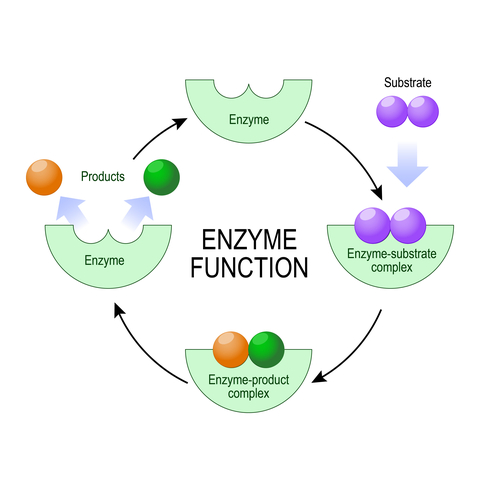
Carbonic Anhydrase
In its simplest terms, an enzyme is a ‘go faster’ specifically built, chemical protein. The metabolic ‘machinery inside each cell relies on these proteins to create rapid chemical reactions. Enzymes are built by the cells themselves ( a marvel of cellular chemistry). Enzymes are not just any old protein, they are built specifically for a particular reaction to occur. For example Carbonic anhydrase, if it were placed into soda water it will cause the soda water to rapidly release carbon dioxide so chemically carbonic acid (H2CO3) is decomposed at high speed into carbon dioxide (CO2) and water (H20) ( carbonated water). The ‘Fizz’ of the soda water soon goes flat if left open since the spontaneous decomposition of the carbonic acid quickly dies out. In the body, we are a cellular oxygen organism, that uses oxygen for metabolic and energy production processes, from which, exhaust or waste is generated in the form of carbon dioxide. where the blood is used to transport it out of the body exhaled from the lungs. In fact carbonic acid is known as a respiratory acid since it is the only acid excreted as a gas by the lungs. The blood achieves this feat by using an intermediate substance Bicarbonate ( alkalised carbonic acid); a hydration reaction of CO2 without a catalyst ( enzyme ),which is too slow for the bodies processes, but the red blood cells contain carbonic anhydrase, the go faster enzyme, to speed up this reaction. The CO2 is dissolved in the blood plasma, which then gets shipped to the lungs that reverse the reaction by converting the bicarbonate into CO2 gas which gets expelled.
Catalase
Another common enzyme produced by the cell is Catalase, primarily used to break down Hydrogen peroxide (H202) into oxygen and water and protect the cell from oxidative damage from reactive oxygen species (ROS), also known as free radicals. In fact, if you have read article # VIII ‘Nutrients required for cellular energy production’ I spoke about Glutathione peroxidase which is also, equally active in the mitochondria of the cell, as is Catalase ( evidenced by a study conducted by Gaetani et al in 1989 referenced at the end of this article). So where does hydrogen peroxide come from ?. In the referenced article we mentioned Superoxide formation produced by molecular oxygen leakage, caused by unused energy from the electron transport chain (ETC) which can occur due to energy demand ( too much fuel produced relative to demand such as in a sedentary individual), ETC decoupling etc. These superoxide free radicals are the most damaging molecules to the mitochondria, so they must be eliminated rapidly. The cell uses Superoxide dismutase to convert the superoxide free radicals into hydrogen peroxide which is also damaging, but less so, nethertheless, Catalase and/or Glutathione peroxidase then convert the hydrogen peroxide into oxygen and water. If you disinfect a cut using hydrogen peroxide you will notice the wound will begin to bubble, because the blood cells contain catalase that break down the hydrogen peroxide. If you watch any detective show on TV like CSI, you will witness the use of Luminol and hydrogen peroxide by crime scene investigators to see if blood is present that may have been cleaned at the crime scene. If blood is present the peroxide will decompose and yield oxygen, and react with the luminol producing a blue glow in the dark. We can thank forensic scientist Walter Specht, who put this into practice in 1937. From a nutrient standpoint, since Catalase contains 4 iron heme groups among the 500 amino acid constituents, Iron is required in the cell, and Glutathione peroxidase requires Glutathione that is made in the body. Due to ageing, glutathione production diminishes, so it is recommended that you include the amino acid constituents of Glutathione which are L-Cysteine, L-Glutamic acid, and Glycine which the body can uses to build glutathione. Glutathione in its ‘whole form’, found in asparagus, avocado, spinach, okra, broccoli, the body is unable to use, since it would have to break it down into amino acid form, an inefficient step that the body probably avoids since many dietary sources contain most of the amino acids. Whey protein concentrate ( avoid Isolate) from grass-fed animals and raw milk is a good supplement that has the complete amino acid complex.
Enzyme Kinetics
A science exists that studies the chemical reactions that are catalysed by enzymes. This school of science measures the reaction rate and the various conditions associated with the reaction revealing the catalytic mechanism. Yes you’ve guessed it…drug companies use this science to poison the body using drugs to inhibit enzymatic action. As the great Dr Roger Williams, discoverer of Vitamin B5 (Pantothenic acid) explains, enzymes do not contribute to the actual chemical reaction, their role serves as an extremely effective lubricant. The substance that the enzyme affects is called a ‘substrate’, that the specific enzymes bind to, using particular locations on the enzyme molecule called binding ‘Hot spots’. When cells burn glucose for fuel, several enzymes are used to catalyse the glucose product, where one enzyme will initially work on the glucose, modifying it, and producing a substrate for another enzyme to go to work, until the glucose molecule becomes a series of fragments that the cell can use for energy production. Cells are busy factories using many enzymes to produce energy, and producing its own structures including enzymes and proteins. Protease for example, digest long protein chains by splitting them into shorter fragments, and others such as trypsin attack internal peptide bonds of proteins, destroying their targets, which is basis of cancer elimination as described in the articles ‘ Cancer – Navigating the historical road to truth’:
https://www.extremehealthacademy.com/cancer-navigating-the-historical-road-to-truth-part-1/
Not all biological catalysts are protein enzymes ( catalytic proteins). Ribozymes ( Ribonucleic acid enzymes) or RNA catalysts are composed of Nucleic acids, as opposed to protein enzymes which are polymers that are made up of amino acids. Nucleotides are also made of polymers (such as in synthetic plastic like polystyrene) or biopolymers produced naturally for DNA. The basic difference between proteins and nucleic acids is, proteins are made from a series of amino acids where an amino acid consists of a central carbon, bonded to 4 different chemical groups (the 4th group differentiates the amino acid type). Nucleic acids on the other hand ,are made up of a series of nucleotides, where a nucleotide is composed of a 5 carbon sugar, a nitrogenous base ( Purine, and Pyrimidine ) and a phosphate group. Since methylation relys on the work of hundreds of enzymes, many of these enzymes require mineral nutrient cofactors including Cobalt, copper, Managanese iron etc. It is absolutely crucial that there is an arsenal of the 90 essential nutrients for the body to draw down from as needed especially for the complex mechanism of epigenetic expression such as in DNA Methylation. In the next section we will revisit this fascinating and highly complex mechanism of epigentic gene expression.
Epigenetics I
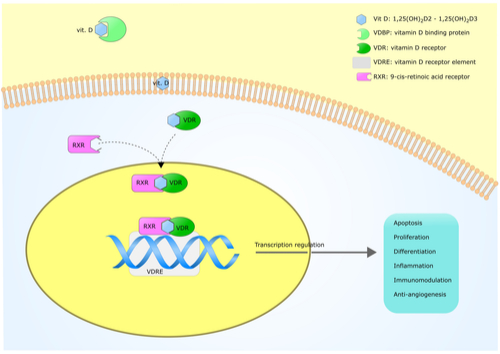
The very first article I wrote for Dr. Bergman D.C. was called ‘Ome research – Genetics and Epigenetics’. I would like to recall some of the text. Genome scientists for many years conducting DNA research noticed that the gene clusters located within the 46 chromosomes were separated by stretches of DNA that were not used for coding for cell reproduction and were thought to be superfluous, so it was thrown away. Unbeknown to the scientists the so called ‘junk’ was in fact the regulatory protein used in epigenetic gene control ( biologists label the coding part of DNA Exons and the epigenetic switching part Introns). Epigenetic gene expression is far more complicated than our cells just simply reading a fixed blueprint ( DNA) for cell reproduction. For 50 years scientists believed (and is still in some biology textbooks) that the genes we inherited were fixed in stone and that we all were a ‘victim of our genes’ that we had no control over. If dad had prostate cancer then there is a good chance that his son would inherit the gene that expresses this condition which is why human ‘disease’ was thought to be, by and large genetic. Even now most doctors still believe this to be true. It followed that the majority of earth’s population were led down the road of genetics being the root of most bodily ailments.
DNA -A cursory introduction
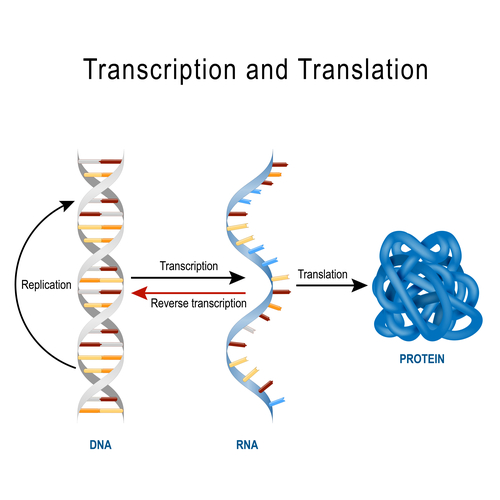
We now know that our genome has 3.2 billion bases. Our genes are part of the DNA made from chemical substances Adenine, Cytosine, Guanine and Thymine A,C,G,T. Since DNA is a double helix, A can only pair with T, and C with G which are base pair nucleotides. The average size gene is 3000 bases, and the largest gene is measured to be 2.4 million bases, which is Dystrophin (a gene that makes a protein for muscle integrity found in skeletal muscle and the heart ) and Chromosome 1 houses the most genes = 4000+. As you can see, this gets quite complicated, but the point is:
Only 3% of DNA is dedicated to gene expression, the remaining 97% is gene regulation.
Have they discovered what gene expresses our common diseases like diabetes, hypertension, high cholesterol? Of course not because these are all symptoms of other underlying problems. Do certain genes change with these ailments? Yes, genes respond our every activity 24 hours/day including exercising, ingesting food, taking prescription drugs, breathing or lying in the sun ( the absorption of Vitamin D affects over 2000 genes ), sleeping. A new ‘religion’ was born from the Human Genome Project (HGP) called Pharmacogenomics. This involves more personalised medicine. Once prescription drugs are metabolised the recipient’s response is determined partially by their specific gene states expressed (ON ) or silenced (OFF)), so with this understanding, physicians can determine specific drugs and dosages on an individual level. The ultimate goal is to develop genetic tests to predict how patients are going to respond. Coupled with this testing tool, it is envisaged that side effects can be minimised. The HGP identified changes in the nucleotide bases ( A,C,G,T) referred to as SNP (Single Nucleotide Polymorphisms) between individuals, and structural changes in various DNA sections altering chromosomes (affecting some 12% of the genome), including translocation ( genetic material is exchanged between chromosomes). Scientists realize that it’s difficult to ascertain which part of the SNP cause disease and which do not, except through statistical analyses between a number of individuals. They’re looking not only for genes but gene variants that cause disease. This also can involve multiple genes and multiple variants; a bit like trying to hit a moving target. Several companies now have ‘set up shop’ and now providing a service to test your gene ‘snps’ so they can predict if you have any predispositions to any potential disease like dysfunctional methylation, or celiac disease. I would like to know how they can predict these results given our knowledege of epigentics, but, if you want to spend $ 200 or so for a biological ‘tarot’ reading then go ahead.
How DNA is read
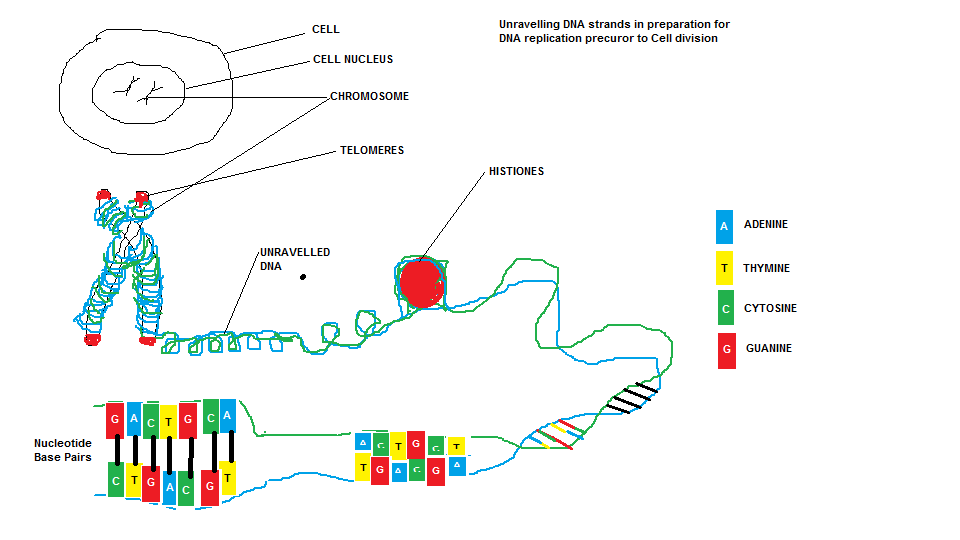
To regulate or control cell expression it is the scaffolding histone proteins that is manipulated chemically (Chemical signalling). The histones are a cluster of base proteins referred to as H3,H4,H2A,H2B ( there are many more H3K4,H3K3,H3K9 etc dependent upon what Chemical signalling is used). Each Histone has an N-Tail attached to it, which is activated by a chemical signal. Histone function is complex, however in order for a section of DNA to be read it must be unwound from a particular histone cluster activated by a particular enzyme. This process involves adding a specific chemical group referred to as a Methylation,Acetylation, Phosphorylation etc group. These enzymes are Histone Methyltransferase ( HMT ) and Histone Acetyltransferase (HAT) to unwrap the DNA section for Methylation and Acetylation respectively. Enzymes to rewrap the DNA are Histone demethylase (HDMC) and Histone deacetylase (HDAC). Specifically these enzymes convert the histones from unmethylated (nonacetylated, unphosphorylated etc) to methylated histones. Once the DNA section is uncovered and read , a copy is made called mRNA ( messenger RNA in this case). This action is referred to as Transcription. Once this is complete, new or recycled histones are produced to rewind the DNA. H4 is generally activated in this way using a acetyl group referred to as Acetylation. This Acetylation cycle, occurring within the cell nucleus, can go through multiple transcriptions, being modified several times before the mRNA produces the final protein sequence that is released into the cytoplasm from the cell nucleus. H3 is generally activated via a Methyl group referred to as Methylation. However the type of methylation depends upon the amino acids ( in this case Lysine or arginine ) attached to its N-Tail. For example H3K3 (H3+Lysine 3) expresses a gene as in the Methylation example, but H3K9 (H3+Lysine 9) leaves the gene unread (thus silencing the gene ).
Our biochemical understanding is just a drop in the ocean
I must impress upon you that histone code is highly complex, and as I mentioned above each of the 4 standard histones H3,H4,H2A,H2B can be simultaneously modified at multiple locations coupled with multiple modifications. As Wikipedia explains that H3 for example contains 19 lysine residues known to be methylated, either unmethylated, monomythelated, dimethylated or trimethylated. This equates to 4 raised to the power of 19 ( 280 billion different lysine methylation patterns which is greater than the total number of histones recorded from the human genome project = approx 44 tightly packed histones). This does not include Lysine acetylation (H3 + 9 residues), Arginine methylation (H3 + 3 residues) or Threonine/Serine/Tyrosine Phosphorylation ( H3 + 8 residues).
Epigenetics II
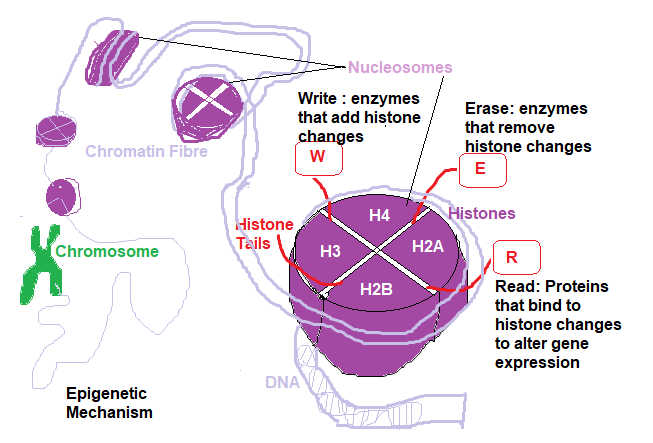
Epigenetic tags
Some months ago I wrote several articles on the basics of epigenetics so again I would like to recall some relevant text. Since the 1970s, it is known that in order for the body to know what type of cell, when divided, is going to be produced when differentiated, a heart cell, a liver cell etc, the DNA within the cell needs additional information that defines specific transcription. This additional information, not dissimilar to a bookmark, is a methyl group (as described earlier), a common hydrocarbon group consisting of one carbon atom and three hydrogen atoms CH3 (abbreviated as ME), structure that exists in many organic compounds derived from Methane. DNA methylation is used as an epigenetic mechanism to regulate/control gene expression. They are in fact Epigenetic tags. The body adds and removes methyl groups attached to genes, or even control sections associated with a gene cluster, based on environmental inputs exogenously and dietary habits endogenously for example throughout life. However, when life begins the new born’s genes are largely ‘reset to a default state’, by removing the epigentic tags that were placed there on the original inherited genes from Mum and Dad. I say largely, we know that some epigenetic changes are passed down from parent to child or from grandmother/father to child as if by-passing the reset mechanism, and these typically imprinted genes and imprinted rgions of the DNA. These heritable epigenetic tags (Imprinted) can be behavioral in origin as explained in the next paragraph
Behavioural epigenetic tags
‘molecular residue holding fast to our gene scaffolding’
I don’t like to coin phrases too often but the phrase ‘Nuture turns to nature’ is very applicable when discussing behavioural epigenetics. From the brilliant research conducted at McGill in 2004, uncovered the relationship of the type and amount of nurturing that a mother rat gives its offspring determines how its offspring behaves as they develop, specifically, in this case how they coped with stress. If the nurturing was adequate the young rats would display a low stress response. To understand this result, researchers discovered a downregulation of the glucocorticoid receptor gene* in the brain by examination of the hippocampus, by the extent of methylation ( epignetic mechanisms are analgous to dimmer switches) which in this case repressed the gene, thus disabling the reading of the gene. Soon after birth of the rat pups, researchers found that methyl groups had repressed the glucocorticoid receptors. This repression meant that the gene was unmethylated and unable to unwind the histone preventing gene transcription. Further experiments examined another rat mother who was not adequately nurturing its young ( very little licking its offspring) and the regulatory genes of its pups were highly methylated (gene repression) creating permanent epigenetic tags that led to the pups nervousness throughout their lifespans. They repeated the experiment, but this time the offspring from the ‘bad’ mother were transferred to the ‘good’ mother and vice versa providing the same results, proving that these were not physiological inheritances, but behavioral inheritances. Finally, to make sure that it was indeed the bad nurturing that caused the highly methylated regulatory genes, they soaked the hippocampus of the offspring from the good mother with Trichostatin a compound known to alter gene expression by interfering with the removal of acetyl groups from histones, and the offspring still showed no sign of stress related problems.When the offspring from bad nurturing became mothers themselves they also became inattentive toward their offspring, also revealing diminished estrogen receptor activity. A useful experiment that proved behaviour influences physical biology.
*Glucocorticoid receptors are expressed in most cells regulating gene expression involved in development, metabolism and immune response. Within the central nervous system these receptors are linked with endocrine functions including stress response on the brain
“While a role for DNA methylation may not have come as a shock, it may be surprising to learn that it is often not the gene body that is methylated. The part of the gene that codes for protein is epigenetically broadly the same when we compare the maternal and paternal copies of the chromosome. It’s the region of the chromosome that controls the expression of the gene that is differently methylated between the two genomes.”
― Nessa Carey, The Epigenetics Revolution: How Modern Biology is Rewriting our Understanding of Genetics, Disease and Inheritance
Check out other Articles in this series:
Nutrients in Food and their bodily purpose I (Phenols)
Nutrients in Food and their bodily purpose II (Lignans, Triterpenes, Phytosterols, Carotenoids & Fats)
Nutrients in Food and their bodily purpose III (Phenolic acids, sulphur, sulphides,sulphoxides )
Nutrients in Food and their bodily purpose IV (Glucosinolates, Sulforaphane, Indole-3-Carbinol)
Nutrients in Food and their bodily purpose V (Lipid distribution, absorbed fats, Criciferous Veg)
Nutrients in Food and their bodily purpose VI (Nutrients required for Liver Detox)
Nutrients in Food and their bodily purpose VII (Seeds & the Omega Fatty Acids)
Nutrients in Food and their bodily purpose VIII (Nutrients required for cellular energy production)
Nutrients in Food and their bodily purpose IX (Water I Properties and Body fluids)
Nutrients in Food and their bodily purpose X (Water II Cellular Hydration)
Nutrients in Food and their bodily purpose XI (Water III Fluid filtration, reabsorption, excretion)
Nutrients in Food and their bodily purpose XII (Water IV Blood pressure, Blood volume regulation)
Nutrients in Food and their bodily purpose XIII (Water V Body Fluid Dysfunction
Nutrients in Food and their bodily purpose XIV (Dental Nutrients)
Nutrients in Food and their bodily purpose XVI (Nutrients involved in Methylation II)
Nutrients in Food and their bodily purpose XVII (Nutrients involved in Methylation III)
Nutrients in Food and their bodily purpose XVIII (Nutrients involved in Methylation IV)
Nutrients in Food and their bodily purpose XIX (Methylation V and the Microbiota I)
Nutrients in Food and their bodily purpose XX (Methylation VI and the Microbiota II)
Nutrients in Food and their bodily purpose XXI (Superfoods: Wheatgrass)
Nutrients in Food and their bodily purpose XXII (Superfoods: Adaptogens)
Nutrients in Food and their bodily purpose XXIII (A look into our nutritional past Sir Robert McCarrison)
Nutrients in Food and their bodily purpose XXIV (Pregnancy: Nature vs Nurture vs Nutrition)
References/Acknowledgments :
- Catalase and glutathione peroxidase are equally active in detoxification of hydrogen peroxide in human erythrocytes Gaetani GF et al 1989 NCBI ( PubMed)
- Hydrogen Peroxide: the body’s best defence system Joe Schwarcz 2017 Mcgill office for science and society
- Catalase, Protease, Nucleotide, Histone Code, Behavioural epigenetics Wikipedia
- Natural sources of Glutathione Hallelujah Diet
- A tool for structure alignment of molecules – difference between proteins and nucleic acids Pei-Ken Chang at al cmlab.csie.ntu.edu.tw
- Epigenetics revolution quotes Goodreads
Author: Eric Malouin